Review of Additive Manufacturing Application in the Food Industry
VerifiedAdded on 2023/06/09
|11
|2679
|326
Literature Review
AI Summary
This literature review examines the intersection of additive manufacturing (AM) technologies and the food industry, focusing on current and future applications. It begins by outlining the challenges faced by the food sector, such as retail considerations, innovation, time to market, and supply chain complexity, and how AM can offer solutions through mass customization and distributed manufacturing. The review details various AM technologies used in food production, including 3D printing, and classifies them according to ASTM standards. It explores the materials used in additive food manufacturing, categorizing them into alternative, natively printable, and non-printable foods, and discusses the properties that influence their printability, post-processing behavior, and applicability. The review also highlights existing applications of AM in rapid prototyping, customization, and tooling, and analyzes the benefits and limitations of AM, including its potential for customized design and simplified supply chains, as well as its current limitations in texture and composition. Finally, the review discusses the future commercial potential of AM in the food industry, emphasizing the need for further research into the use of basic food ingredients and the development of specialized equipment. The document is available on Desklib, a platform offering a wide range of study resources for students.
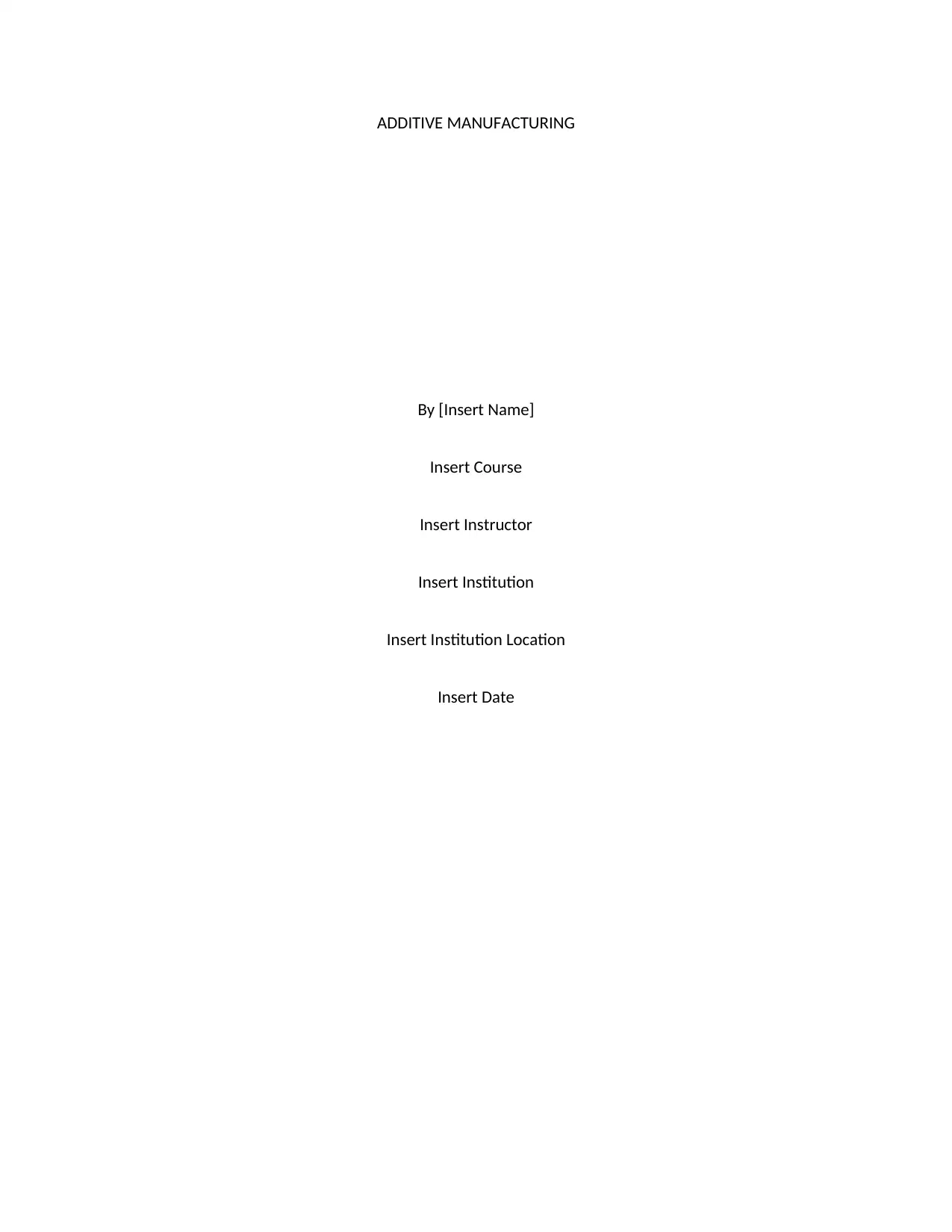
ADDITIVE MANUFACTURING
By [Insert Name]
Insert Course
Insert Instructor
Insert Institution
Insert Institution Location
Insert Date
By [Insert Name]
Insert Course
Insert Instructor
Insert Institution
Insert Institution Location
Insert Date
Paraphrase This Document
Need a fresh take? Get an instant paraphrase of this document with our AI Paraphraser
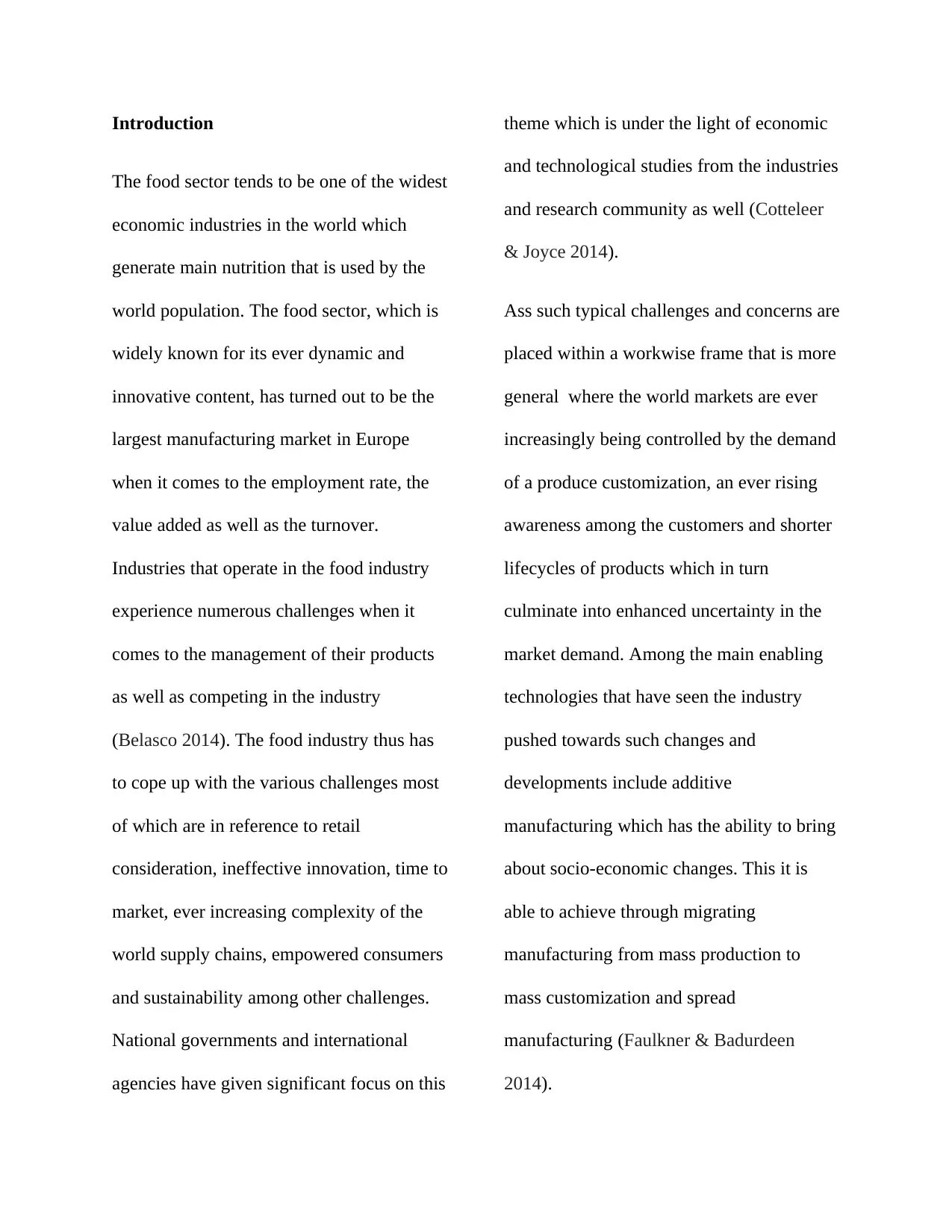
Introduction
The food sector tends to be one of the widest
economic industries in the world which
generate main nutrition that is used by the
world population. The food sector, which is
widely known for its ever dynamic and
innovative content, has turned out to be the
largest manufacturing market in Europe
when it comes to the employment rate, the
value added as well as the turnover.
Industries that operate in the food industry
experience numerous challenges when it
comes to the management of their products
as well as competing in the industry
(Belasco 2014). The food industry thus has
to cope up with the various challenges most
of which are in reference to retail
consideration, ineffective innovation, time to
market, ever increasing complexity of the
world supply chains, empowered consumers
and sustainability among other challenges.
National governments and international
agencies have given significant focus on this
theme which is under the light of economic
and technological studies from the industries
and research community as well (Cotteleer
& Joyce 2014).
Ass such typical challenges and concerns are
placed within a workwise frame that is more
general where the world markets are ever
increasingly being controlled by the demand
of a produce customization, an ever rising
awareness among the customers and shorter
lifecycles of products which in turn
culminate into enhanced uncertainty in the
market demand. Among the main enabling
technologies that have seen the industry
pushed towards such changes and
developments include additive
manufacturing which has the ability to bring
about socio-economic changes. This it is
able to achieve through migrating
manufacturing from mass production to
mass customization and spread
manufacturing (Faulkner & Badurdeen
2014).
The food sector tends to be one of the widest
economic industries in the world which
generate main nutrition that is used by the
world population. The food sector, which is
widely known for its ever dynamic and
innovative content, has turned out to be the
largest manufacturing market in Europe
when it comes to the employment rate, the
value added as well as the turnover.
Industries that operate in the food industry
experience numerous challenges when it
comes to the management of their products
as well as competing in the industry
(Belasco 2014). The food industry thus has
to cope up with the various challenges most
of which are in reference to retail
consideration, ineffective innovation, time to
market, ever increasing complexity of the
world supply chains, empowered consumers
and sustainability among other challenges.
National governments and international
agencies have given significant focus on this
theme which is under the light of economic
and technological studies from the industries
and research community as well (Cotteleer
& Joyce 2014).
Ass such typical challenges and concerns are
placed within a workwise frame that is more
general where the world markets are ever
increasingly being controlled by the demand
of a produce customization, an ever rising
awareness among the customers and shorter
lifecycles of products which in turn
culminate into enhanced uncertainty in the
market demand. Among the main enabling
technologies that have seen the industry
pushed towards such changes and
developments include additive
manufacturing which has the ability to bring
about socio-economic changes. This it is
able to achieve through migrating
manufacturing from mass production to
mass customization and spread
manufacturing (Faulkner & Badurdeen
2014).
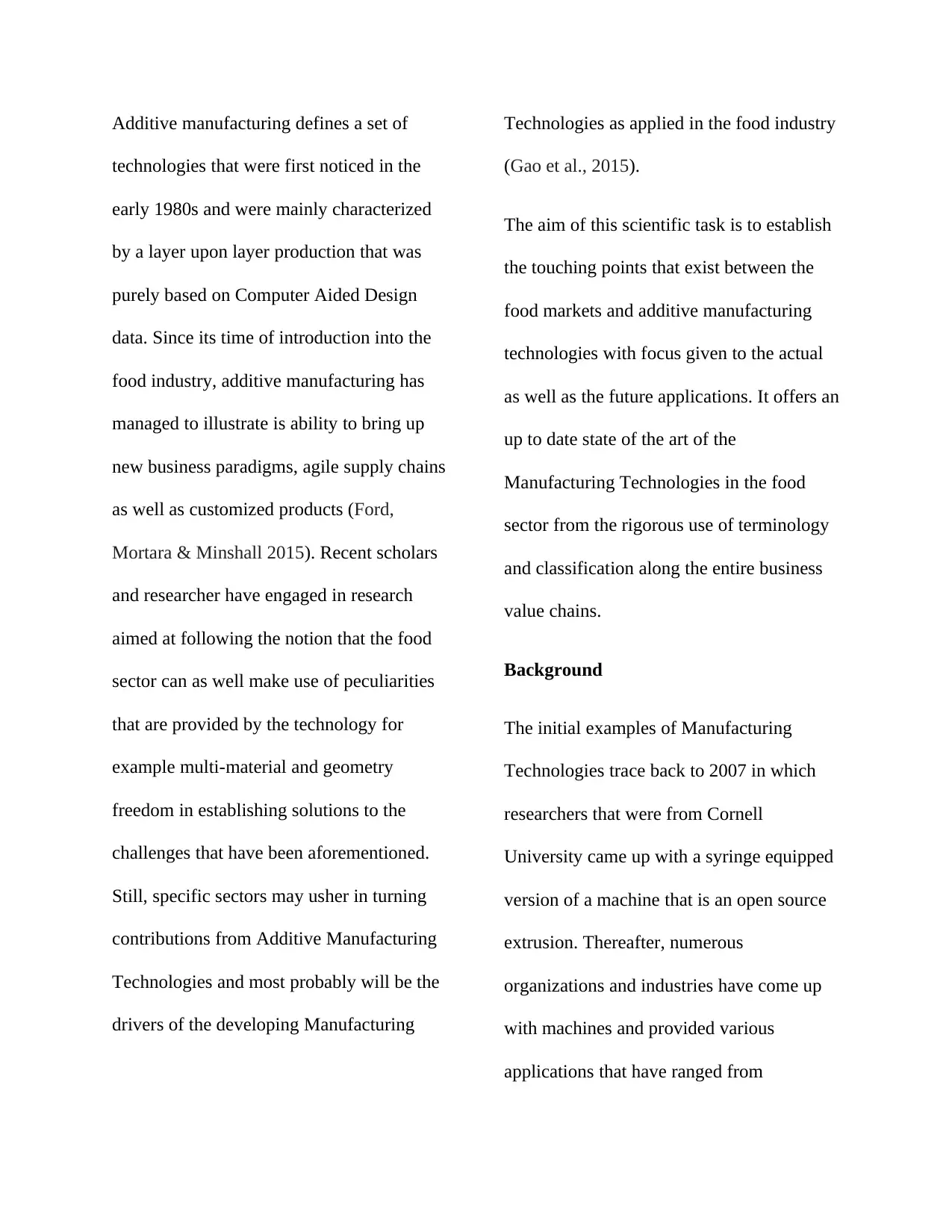
Additive manufacturing defines a set of
technologies that were first noticed in the
early 1980s and were mainly characterized
by a layer upon layer production that was
purely based on Computer Aided Design
data. Since its time of introduction into the
food industry, additive manufacturing has
managed to illustrate is ability to bring up
new business paradigms, agile supply chains
as well as customized products (Ford,
Mortara & Minshall 2015). Recent scholars
and researcher have engaged in research
aimed at following the notion that the food
sector can as well make use of peculiarities
that are provided by the technology for
example multi-material and geometry
freedom in establishing solutions to the
challenges that have been aforementioned.
Still, specific sectors may usher in turning
contributions from Additive Manufacturing
Technologies and most probably will be the
drivers of the developing Manufacturing
Technologies as applied in the food industry
(Gao et al., 2015).
The aim of this scientific task is to establish
the touching points that exist between the
food markets and additive manufacturing
technologies with focus given to the actual
as well as the future applications. It offers an
up to date state of the art of the
Manufacturing Technologies in the food
sector from the rigorous use of terminology
and classification along the entire business
value chains.
Background
The initial examples of Manufacturing
Technologies trace back to 2007 in which
researchers that were from Cornell
University came up with a syringe equipped
version of a machine that is an open source
extrusion. Thereafter, numerous
organizations and industries have come up
with machines and provided various
applications that have ranged from
technologies that were first noticed in the
early 1980s and were mainly characterized
by a layer upon layer production that was
purely based on Computer Aided Design
data. Since its time of introduction into the
food industry, additive manufacturing has
managed to illustrate is ability to bring up
new business paradigms, agile supply chains
as well as customized products (Ford,
Mortara & Minshall 2015). Recent scholars
and researcher have engaged in research
aimed at following the notion that the food
sector can as well make use of peculiarities
that are provided by the technology for
example multi-material and geometry
freedom in establishing solutions to the
challenges that have been aforementioned.
Still, specific sectors may usher in turning
contributions from Additive Manufacturing
Technologies and most probably will be the
drivers of the developing Manufacturing
Technologies as applied in the food industry
(Gao et al., 2015).
The aim of this scientific task is to establish
the touching points that exist between the
food markets and additive manufacturing
technologies with focus given to the actual
as well as the future applications. It offers an
up to date state of the art of the
Manufacturing Technologies in the food
sector from the rigorous use of terminology
and classification along the entire business
value chains.
Background
The initial examples of Manufacturing
Technologies trace back to 2007 in which
researchers that were from Cornell
University came up with a syringe equipped
version of a machine that is an open source
extrusion. Thereafter, numerous
organizations and industries have come up
with machines and provided various
applications that have ranged from
⊘ This is a preview!⊘
Do you want full access?
Subscribe today to unlock all pages.

Trusted by 1+ million students worldwide
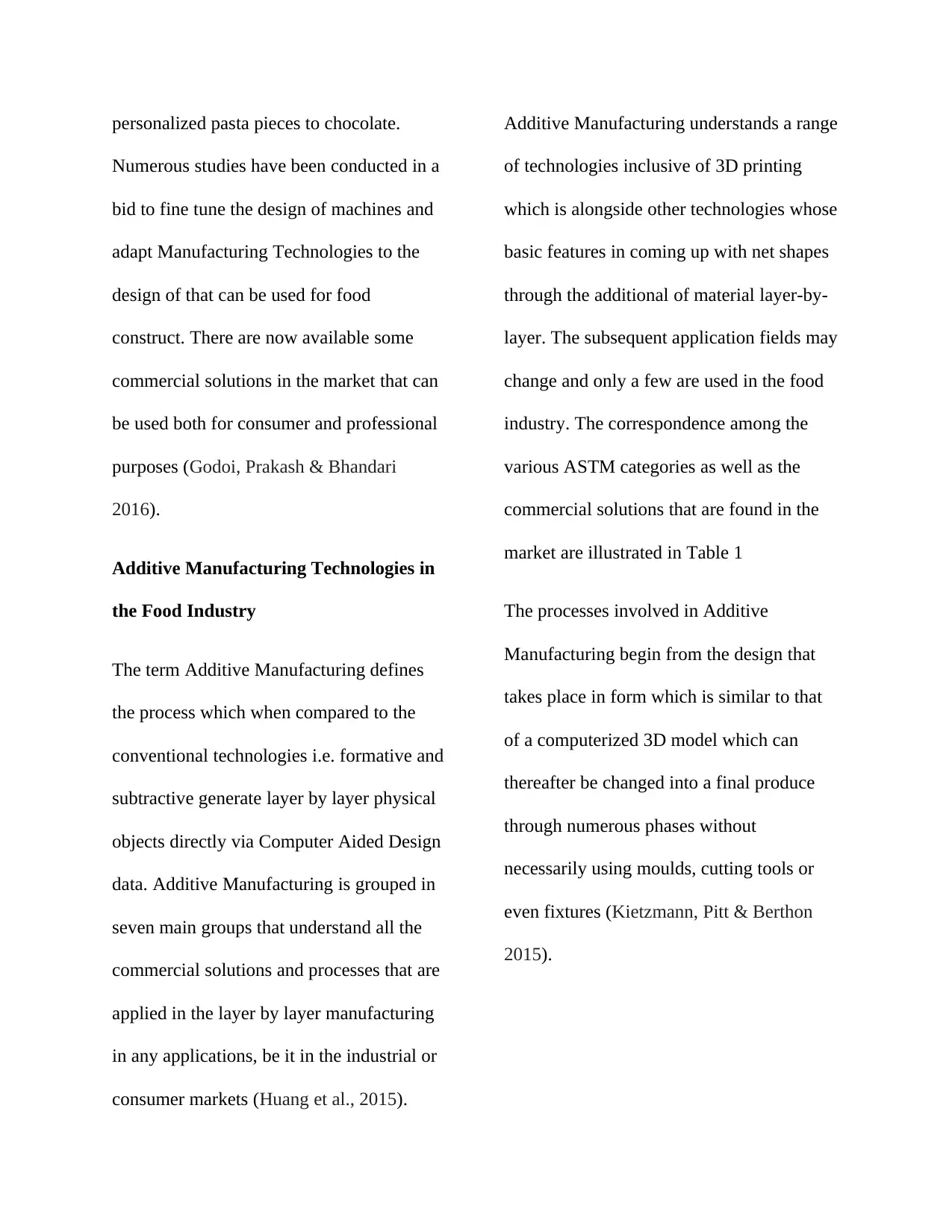
personalized pasta pieces to chocolate.
Numerous studies have been conducted in a
bid to fine tune the design of machines and
adapt Manufacturing Technologies to the
design of that can be used for food
construct. There are now available some
commercial solutions in the market that can
be used both for consumer and professional
purposes (Godoi, Prakash & Bhandari
2016).
Additive Manufacturing Technologies in
the Food Industry
The term Additive Manufacturing defines
the process which when compared to the
conventional technologies i.e. formative and
subtractive generate layer by layer physical
objects directly via Computer Aided Design
data. Additive Manufacturing is grouped in
seven main groups that understand all the
commercial solutions and processes that are
applied in the layer by layer manufacturing
in any applications, be it in the industrial or
consumer markets (Huang et al., 2015).
Additive Manufacturing understands a range
of technologies inclusive of 3D printing
which is alongside other technologies whose
basic features in coming up with net shapes
through the additional of material layer-by-
layer. The subsequent application fields may
change and only a few are used in the food
industry. The correspondence among the
various ASTM categories as well as the
commercial solutions that are found in the
market are illustrated in Table 1
The processes involved in Additive
Manufacturing begin from the design that
takes place in form which is similar to that
of a computerized 3D model which can
thereafter be changed into a final produce
through numerous phases without
necessarily using moulds, cutting tools or
even fixtures (Kietzmann, Pitt & Berthon
2015).
Numerous studies have been conducted in a
bid to fine tune the design of machines and
adapt Manufacturing Technologies to the
design of that can be used for food
construct. There are now available some
commercial solutions in the market that can
be used both for consumer and professional
purposes (Godoi, Prakash & Bhandari
2016).
Additive Manufacturing Technologies in
the Food Industry
The term Additive Manufacturing defines
the process which when compared to the
conventional technologies i.e. formative and
subtractive generate layer by layer physical
objects directly via Computer Aided Design
data. Additive Manufacturing is grouped in
seven main groups that understand all the
commercial solutions and processes that are
applied in the layer by layer manufacturing
in any applications, be it in the industrial or
consumer markets (Huang et al., 2015).
Additive Manufacturing understands a range
of technologies inclusive of 3D printing
which is alongside other technologies whose
basic features in coming up with net shapes
through the additional of material layer-by-
layer. The subsequent application fields may
change and only a few are used in the food
industry. The correspondence among the
various ASTM categories as well as the
commercial solutions that are found in the
market are illustrated in Table 1
The processes involved in Additive
Manufacturing begin from the design that
takes place in form which is similar to that
of a computerized 3D model which can
thereafter be changed into a final produce
through numerous phases without
necessarily using moulds, cutting tools or
even fixtures (Kietzmann, Pitt & Berthon
2015).
Paraphrase This Document
Need a fresh take? Get an instant paraphrase of this document with our AI Paraphraser
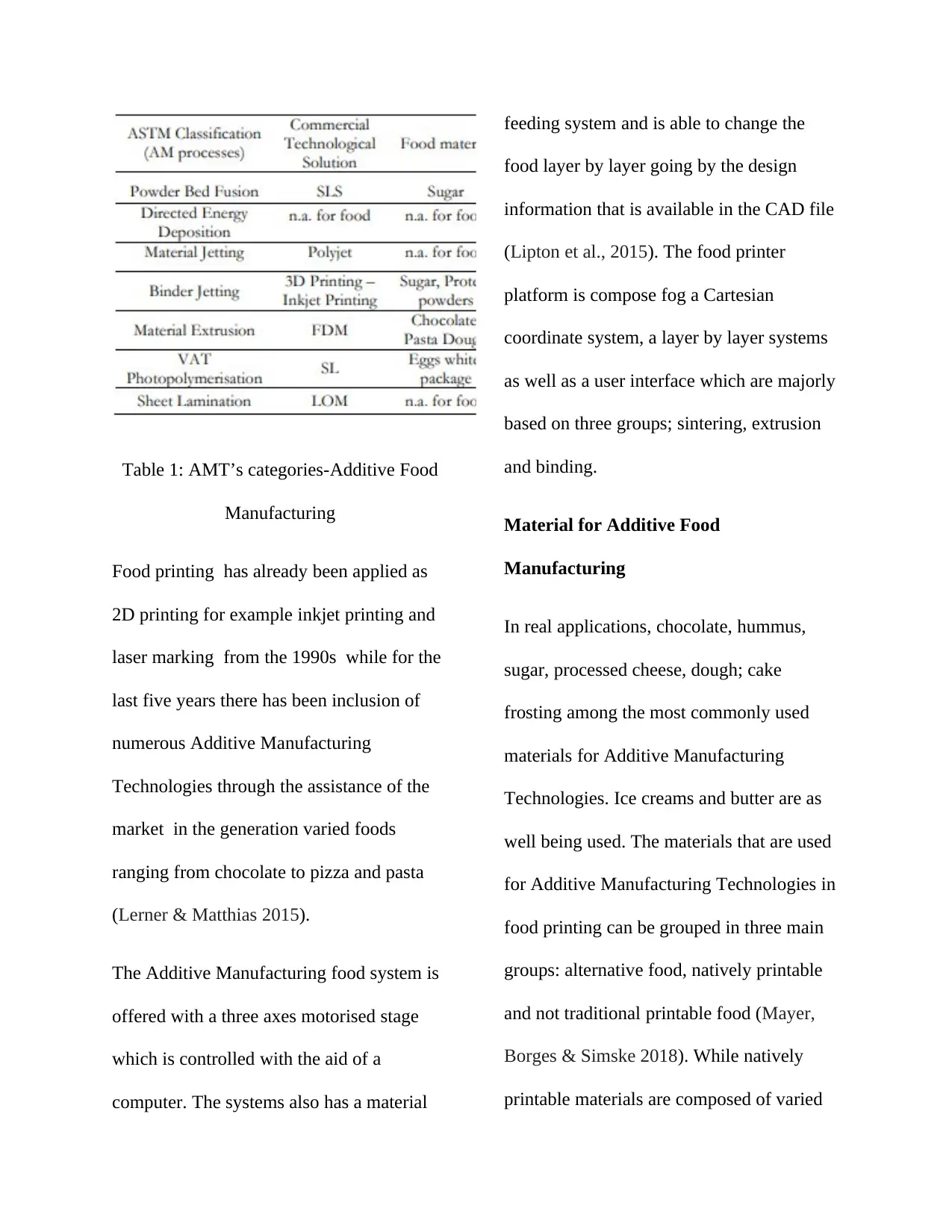
Table 1: AMT’s categories-Additive Food
Manufacturing
Food printing has already been applied as
2D printing for example inkjet printing and
laser marking from the 1990s while for the
last five years there has been inclusion of
numerous Additive Manufacturing
Technologies through the assistance of the
market in the generation varied foods
ranging from chocolate to pizza and pasta
(Lerner & Matthias 2015).
The Additive Manufacturing food system is
offered with a three axes motorised stage
which is controlled with the aid of a
computer. The systems also has a material
feeding system and is able to change the
food layer by layer going by the design
information that is available in the CAD file
(Lipton et al., 2015). The food printer
platform is compose fog a Cartesian
coordinate system, a layer by layer systems
as well as a user interface which are majorly
based on three groups; sintering, extrusion
and binding.
Material for Additive Food
Manufacturing
In real applications, chocolate, hummus,
sugar, processed cheese, dough; cake
frosting among the most commonly used
materials for Additive Manufacturing
Technologies. Ice creams and butter are as
well being used. The materials that are used
for Additive Manufacturing Technologies in
food printing can be grouped in three main
groups: alternative food, natively printable
and not traditional printable food (Mayer,
Borges & Simske 2018). While natively
printable materials are composed of varied
Manufacturing
Food printing has already been applied as
2D printing for example inkjet printing and
laser marking from the 1990s while for the
last five years there has been inclusion of
numerous Additive Manufacturing
Technologies through the assistance of the
market in the generation varied foods
ranging from chocolate to pizza and pasta
(Lerner & Matthias 2015).
The Additive Manufacturing food system is
offered with a three axes motorised stage
which is controlled with the aid of a
computer. The systems also has a material
feeding system and is able to change the
food layer by layer going by the design
information that is available in the CAD file
(Lipton et al., 2015). The food printer
platform is compose fog a Cartesian
coordinate system, a layer by layer systems
as well as a user interface which are majorly
based on three groups; sintering, extrusion
and binding.
Material for Additive Food
Manufacturing
In real applications, chocolate, hummus,
sugar, processed cheese, dough; cake
frosting among the most commonly used
materials for Additive Manufacturing
Technologies. Ice creams and butter are as
well being used. The materials that are used
for Additive Manufacturing Technologies in
food printing can be grouped in three main
groups: alternative food, natively printable
and not traditional printable food (Mayer,
Borges & Simske 2018). While natively
printable materials are composed of varied
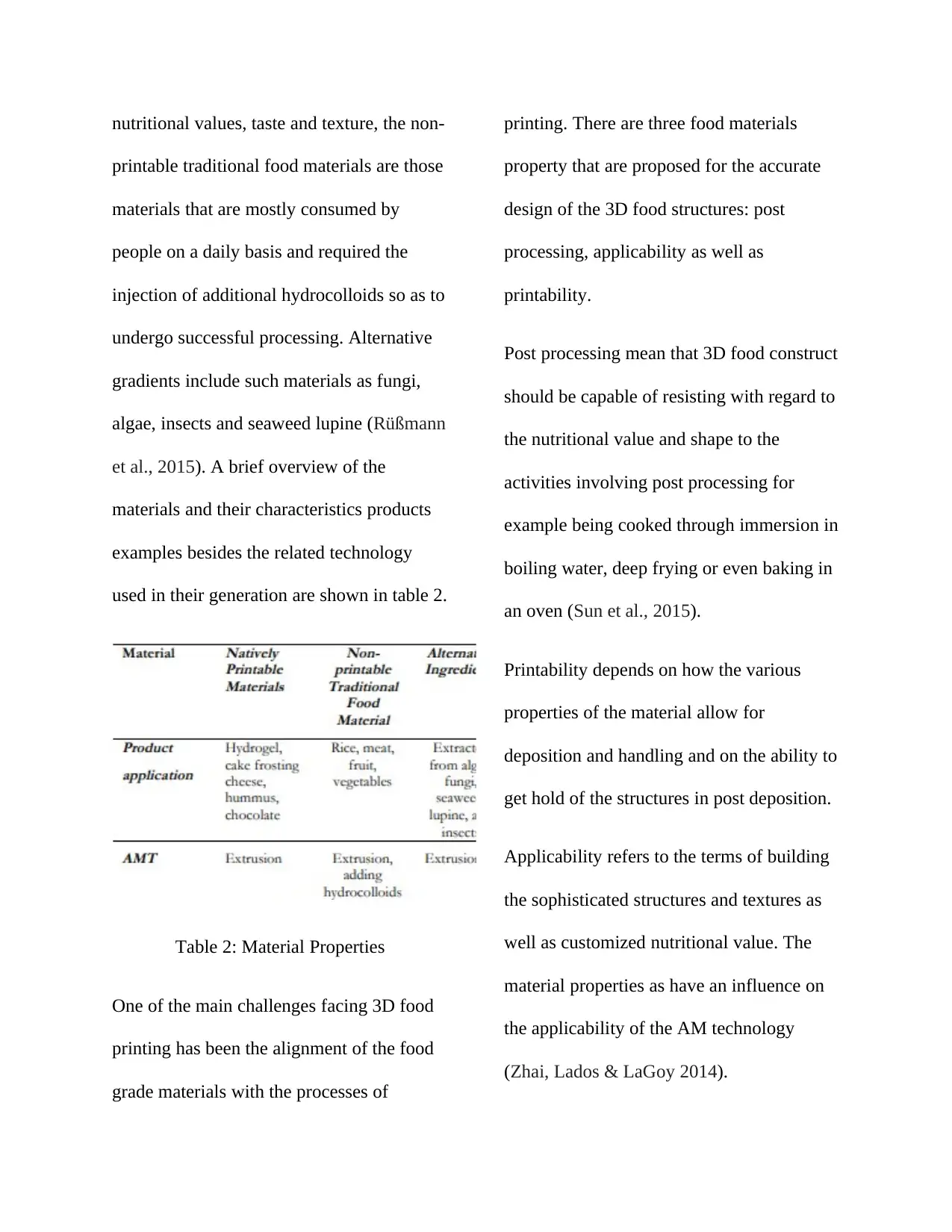
nutritional values, taste and texture, the non-
printable traditional food materials are those
materials that are mostly consumed by
people on a daily basis and required the
injection of additional hydrocolloids so as to
undergo successful processing. Alternative
gradients include such materials as fungi,
algae, insects and seaweed lupine (Rüßmann
et al., 2015). A brief overview of the
materials and their characteristics products
examples besides the related technology
used in their generation are shown in table 2.
Table 2: Material Properties
One of the main challenges facing 3D food
printing has been the alignment of the food
grade materials with the processes of
printing. There are three food materials
property that are proposed for the accurate
design of the 3D food structures: post
processing, applicability as well as
printability.
Post processing mean that 3D food construct
should be capable of resisting with regard to
the nutritional value and shape to the
activities involving post processing for
example being cooked through immersion in
boiling water, deep frying or even baking in
an oven (Sun et al., 2015).
Printability depends on how the various
properties of the material allow for
deposition and handling and on the ability to
get hold of the structures in post deposition.
Applicability refers to the terms of building
the sophisticated structures and textures as
well as customized nutritional value. The
material properties as have an influence on
the applicability of the AM technology
(Zhai, Lados & LaGoy 2014).
printable traditional food materials are those
materials that are mostly consumed by
people on a daily basis and required the
injection of additional hydrocolloids so as to
undergo successful processing. Alternative
gradients include such materials as fungi,
algae, insects and seaweed lupine (Rüßmann
et al., 2015). A brief overview of the
materials and their characteristics products
examples besides the related technology
used in their generation are shown in table 2.
Table 2: Material Properties
One of the main challenges facing 3D food
printing has been the alignment of the food
grade materials with the processes of
printing. There are three food materials
property that are proposed for the accurate
design of the 3D food structures: post
processing, applicability as well as
printability.
Post processing mean that 3D food construct
should be capable of resisting with regard to
the nutritional value and shape to the
activities involving post processing for
example being cooked through immersion in
boiling water, deep frying or even baking in
an oven (Sun et al., 2015).
Printability depends on how the various
properties of the material allow for
deposition and handling and on the ability to
get hold of the structures in post deposition.
Applicability refers to the terms of building
the sophisticated structures and textures as
well as customized nutritional value. The
material properties as have an influence on
the applicability of the AM technology
(Zhai, Lados & LaGoy 2014).
⊘ This is a preview!⊘
Do you want full access?
Subscribe today to unlock all pages.

Trusted by 1+ million students worldwide
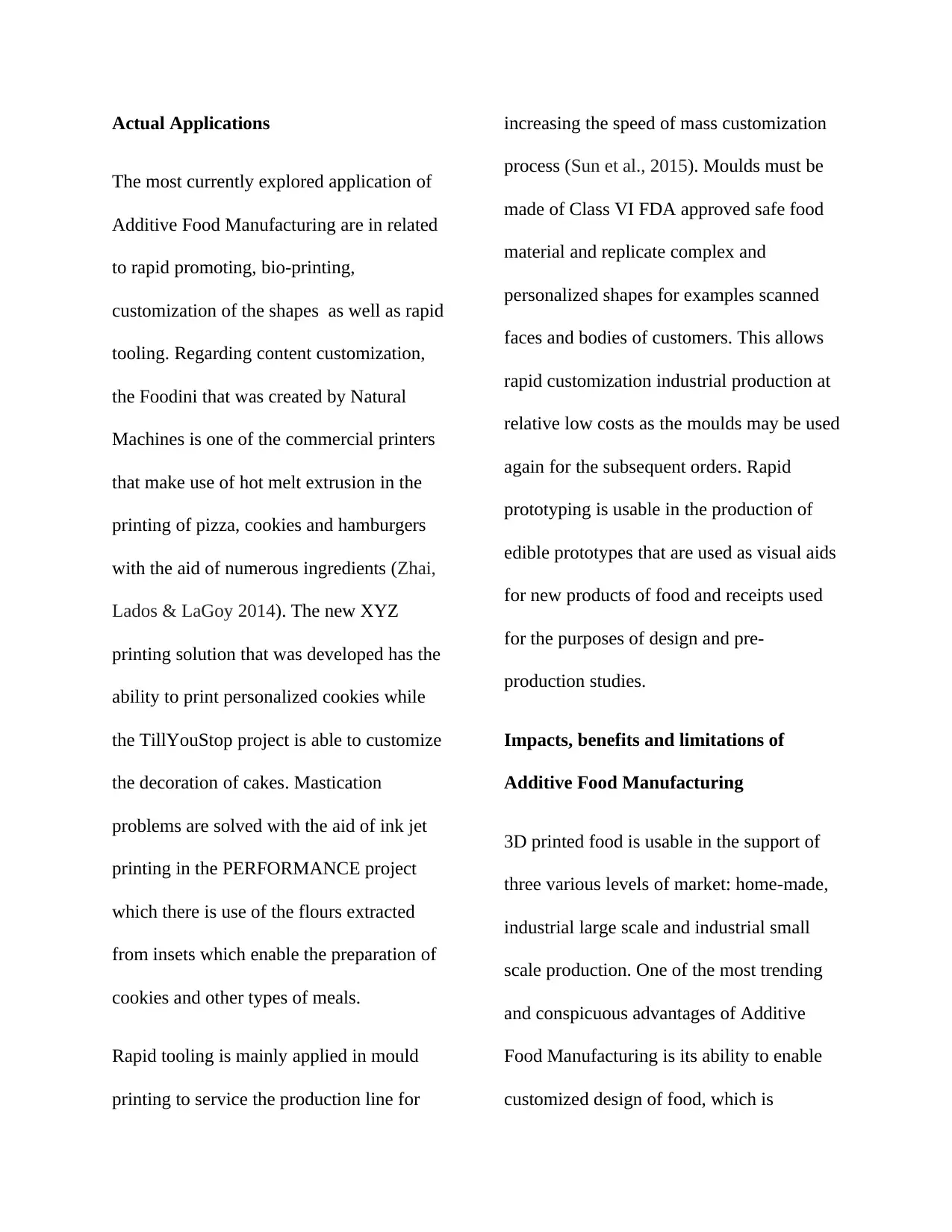
Actual Applications
The most currently explored application of
Additive Food Manufacturing are in related
to rapid promoting, bio-printing,
customization of the shapes as well as rapid
tooling. Regarding content customization,
the Foodini that was created by Natural
Machines is one of the commercial printers
that make use of hot melt extrusion in the
printing of pizza, cookies and hamburgers
with the aid of numerous ingredients (Zhai,
Lados & LaGoy 2014). The new XYZ
printing solution that was developed has the
ability to print personalized cookies while
the TillYouStop project is able to customize
the decoration of cakes. Mastication
problems are solved with the aid of ink jet
printing in the PERFORMANCE project
which there is use of the flours extracted
from insets which enable the preparation of
cookies and other types of meals.
Rapid tooling is mainly applied in mould
printing to service the production line for
increasing the speed of mass customization
process (Sun et al., 2015). Moulds must be
made of Class VI FDA approved safe food
material and replicate complex and
personalized shapes for examples scanned
faces and bodies of customers. This allows
rapid customization industrial production at
relative low costs as the moulds may be used
again for the subsequent orders. Rapid
prototyping is usable in the production of
edible prototypes that are used as visual aids
for new products of food and receipts used
for the purposes of design and pre-
production studies.
Impacts, benefits and limitations of
Additive Food Manufacturing
3D printed food is usable in the support of
three various levels of market: home-made,
industrial large scale and industrial small
scale production. One of the most trending
and conspicuous advantages of Additive
Food Manufacturing is its ability to enable
customized design of food, which is
The most currently explored application of
Additive Food Manufacturing are in related
to rapid promoting, bio-printing,
customization of the shapes as well as rapid
tooling. Regarding content customization,
the Foodini that was created by Natural
Machines is one of the commercial printers
that make use of hot melt extrusion in the
printing of pizza, cookies and hamburgers
with the aid of numerous ingredients (Zhai,
Lados & LaGoy 2014). The new XYZ
printing solution that was developed has the
ability to print personalized cookies while
the TillYouStop project is able to customize
the decoration of cakes. Mastication
problems are solved with the aid of ink jet
printing in the PERFORMANCE project
which there is use of the flours extracted
from insets which enable the preparation of
cookies and other types of meals.
Rapid tooling is mainly applied in mould
printing to service the production line for
increasing the speed of mass customization
process (Sun et al., 2015). Moulds must be
made of Class VI FDA approved safe food
material and replicate complex and
personalized shapes for examples scanned
faces and bodies of customers. This allows
rapid customization industrial production at
relative low costs as the moulds may be used
again for the subsequent orders. Rapid
prototyping is usable in the production of
edible prototypes that are used as visual aids
for new products of food and receipts used
for the purposes of design and pre-
production studies.
Impacts, benefits and limitations of
Additive Food Manufacturing
3D printed food is usable in the support of
three various levels of market: home-made,
industrial large scale and industrial small
scale production. One of the most trending
and conspicuous advantages of Additive
Food Manufacturing is its ability to enable
customized design of food, which is
Paraphrase This Document
Need a fresh take? Get an instant paraphrase of this document with our AI Paraphraser
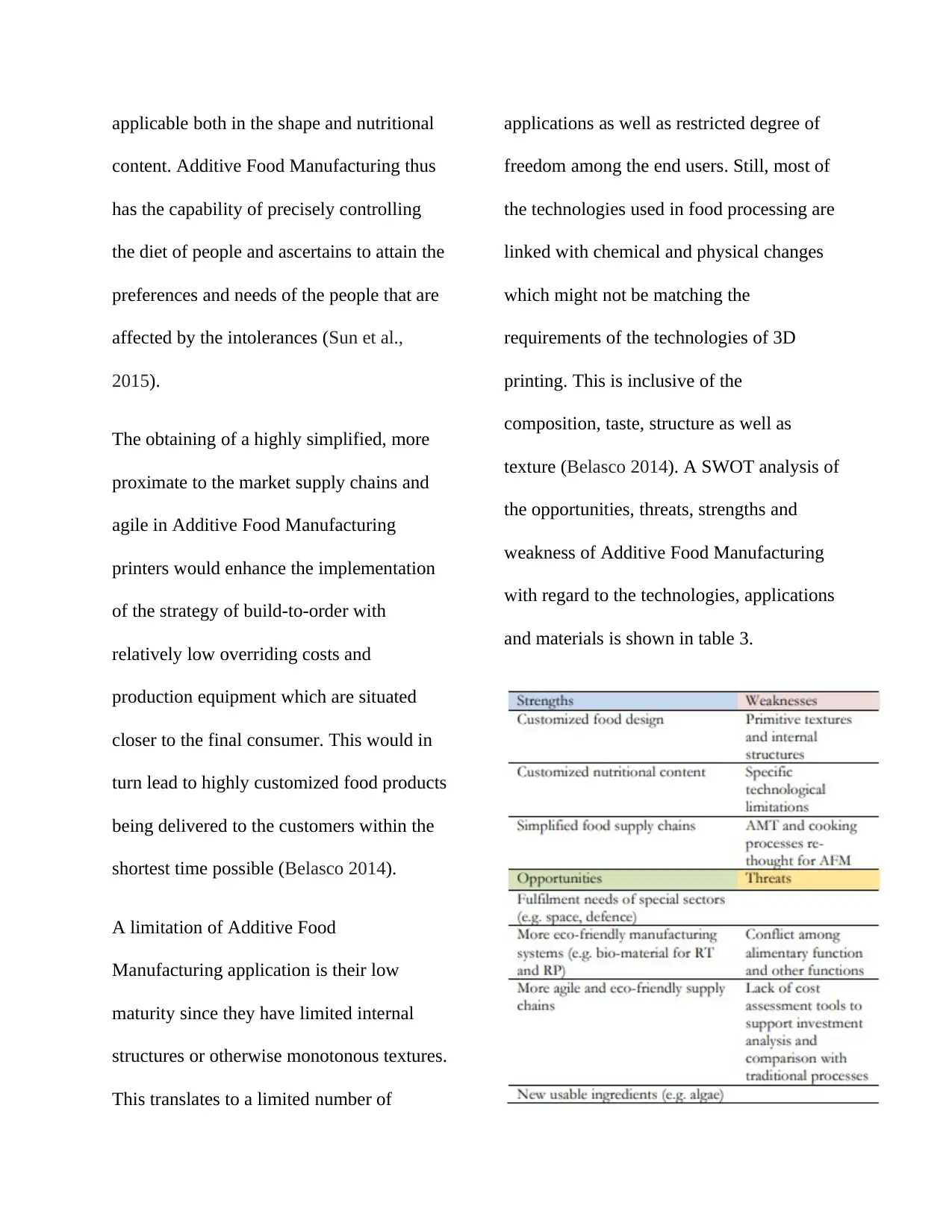
applicable both in the shape and nutritional
content. Additive Food Manufacturing thus
has the capability of precisely controlling
the diet of people and ascertains to attain the
preferences and needs of the people that are
affected by the intolerances (Sun et al.,
2015).
The obtaining of a highly simplified, more
proximate to the market supply chains and
agile in Additive Food Manufacturing
printers would enhance the implementation
of the strategy of build-to-order with
relatively low overriding costs and
production equipment which are situated
closer to the final consumer. This would in
turn lead to highly customized food products
being delivered to the customers within the
shortest time possible (Belasco 2014).
A limitation of Additive Food
Manufacturing application is their low
maturity since they have limited internal
structures or otherwise monotonous textures.
This translates to a limited number of
applications as well as restricted degree of
freedom among the end users. Still, most of
the technologies used in food processing are
linked with chemical and physical changes
which might not be matching the
requirements of the technologies of 3D
printing. This is inclusive of the
composition, taste, structure as well as
texture (Belasco 2014). A SWOT analysis of
the opportunities, threats, strengths and
weakness of Additive Food Manufacturing
with regard to the technologies, applications
and materials is shown in table 3.
content. Additive Food Manufacturing thus
has the capability of precisely controlling
the diet of people and ascertains to attain the
preferences and needs of the people that are
affected by the intolerances (Sun et al.,
2015).
The obtaining of a highly simplified, more
proximate to the market supply chains and
agile in Additive Food Manufacturing
printers would enhance the implementation
of the strategy of build-to-order with
relatively low overriding costs and
production equipment which are situated
closer to the final consumer. This would in
turn lead to highly customized food products
being delivered to the customers within the
shortest time possible (Belasco 2014).
A limitation of Additive Food
Manufacturing application is their low
maturity since they have limited internal
structures or otherwise monotonous textures.
This translates to a limited number of
applications as well as restricted degree of
freedom among the end users. Still, most of
the technologies used in food processing are
linked with chemical and physical changes
which might not be matching the
requirements of the technologies of 3D
printing. This is inclusive of the
composition, taste, structure as well as
texture (Belasco 2014). A SWOT analysis of
the opportunities, threats, strengths and
weakness of Additive Food Manufacturing
with regard to the technologies, applications
and materials is shown in table 3.
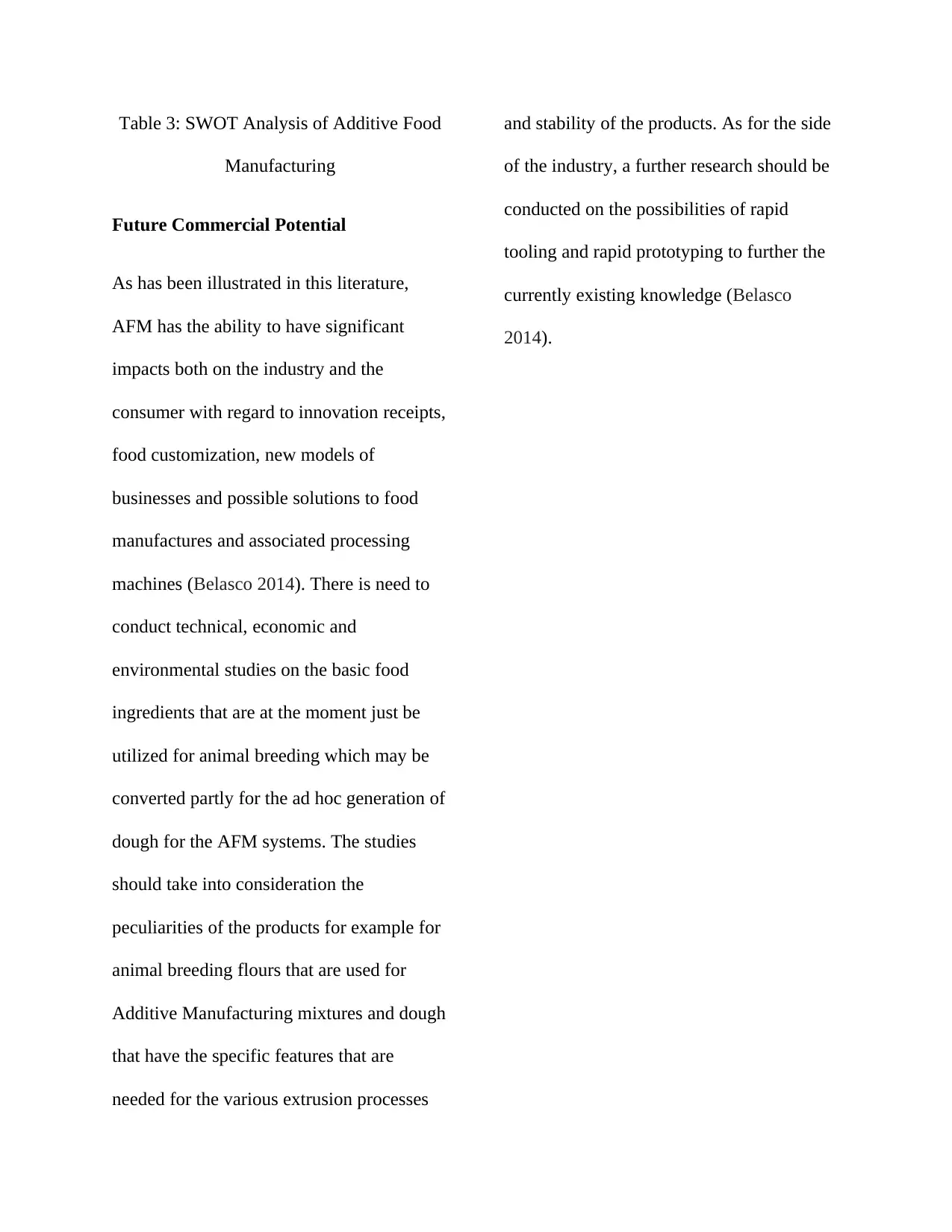
Table 3: SWOT Analysis of Additive Food
Manufacturing
Future Commercial Potential
As has been illustrated in this literature,
AFM has the ability to have significant
impacts both on the industry and the
consumer with regard to innovation receipts,
food customization, new models of
businesses and possible solutions to food
manufactures and associated processing
machines (Belasco 2014). There is need to
conduct technical, economic and
environmental studies on the basic food
ingredients that are at the moment just be
utilized for animal breeding which may be
converted partly for the ad hoc generation of
dough for the AFM systems. The studies
should take into consideration the
peculiarities of the products for example for
animal breeding flours that are used for
Additive Manufacturing mixtures and dough
that have the specific features that are
needed for the various extrusion processes
and stability of the products. As for the side
of the industry, a further research should be
conducted on the possibilities of rapid
tooling and rapid prototyping to further the
currently existing knowledge (Belasco
2014).
Manufacturing
Future Commercial Potential
As has been illustrated in this literature,
AFM has the ability to have significant
impacts both on the industry and the
consumer with regard to innovation receipts,
food customization, new models of
businesses and possible solutions to food
manufactures and associated processing
machines (Belasco 2014). There is need to
conduct technical, economic and
environmental studies on the basic food
ingredients that are at the moment just be
utilized for animal breeding which may be
converted partly for the ad hoc generation of
dough for the AFM systems. The studies
should take into consideration the
peculiarities of the products for example for
animal breeding flours that are used for
Additive Manufacturing mixtures and dough
that have the specific features that are
needed for the various extrusion processes
and stability of the products. As for the side
of the industry, a further research should be
conducted on the possibilities of rapid
tooling and rapid prototyping to further the
currently existing knowledge (Belasco
2014).
⊘ This is a preview!⊘
Do you want full access?
Subscribe today to unlock all pages.

Trusted by 1+ million students worldwide
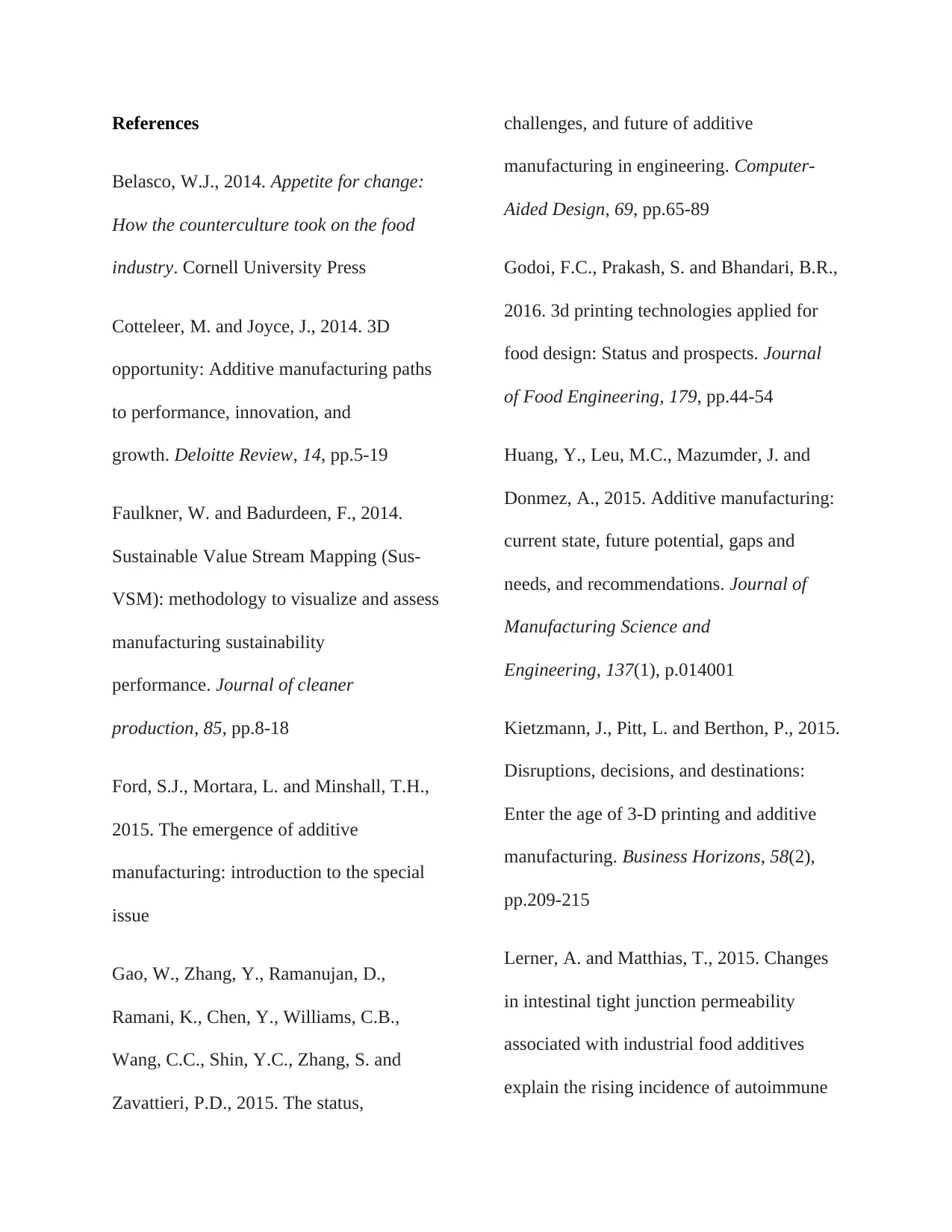
References
Belasco, W.J., 2014. Appetite for change:
How the counterculture took on the food
industry. Cornell University Press
Cotteleer, M. and Joyce, J., 2014. 3D
opportunity: Additive manufacturing paths
to performance, innovation, and
growth. Deloitte Review, 14, pp.5-19
Faulkner, W. and Badurdeen, F., 2014.
Sustainable Value Stream Mapping (Sus-
VSM): methodology to visualize and assess
manufacturing sustainability
performance. Journal of cleaner
production, 85, pp.8-18
Ford, S.J., Mortara, L. and Minshall, T.H.,
2015. The emergence of additive
manufacturing: introduction to the special
issue
Gao, W., Zhang, Y., Ramanujan, D.,
Ramani, K., Chen, Y., Williams, C.B.,
Wang, C.C., Shin, Y.C., Zhang, S. and
Zavattieri, P.D., 2015. The status,
challenges, and future of additive
manufacturing in engineering. Computer-
Aided Design, 69, pp.65-89
Godoi, F.C., Prakash, S. and Bhandari, B.R.,
2016. 3d printing technologies applied for
food design: Status and prospects. Journal
of Food Engineering, 179, pp.44-54
Huang, Y., Leu, M.C., Mazumder, J. and
Donmez, A., 2015. Additive manufacturing:
current state, future potential, gaps and
needs, and recommendations. Journal of
Manufacturing Science and
Engineering, 137(1), p.014001
Kietzmann, J., Pitt, L. and Berthon, P., 2015.
Disruptions, decisions, and destinations:
Enter the age of 3-D printing and additive
manufacturing. Business Horizons, 58(2),
pp.209-215
Lerner, A. and Matthias, T., 2015. Changes
in intestinal tight junction permeability
associated with industrial food additives
explain the rising incidence of autoimmune
Belasco, W.J., 2014. Appetite for change:
How the counterculture took on the food
industry. Cornell University Press
Cotteleer, M. and Joyce, J., 2014. 3D
opportunity: Additive manufacturing paths
to performance, innovation, and
growth. Deloitte Review, 14, pp.5-19
Faulkner, W. and Badurdeen, F., 2014.
Sustainable Value Stream Mapping (Sus-
VSM): methodology to visualize and assess
manufacturing sustainability
performance. Journal of cleaner
production, 85, pp.8-18
Ford, S.J., Mortara, L. and Minshall, T.H.,
2015. The emergence of additive
manufacturing: introduction to the special
issue
Gao, W., Zhang, Y., Ramanujan, D.,
Ramani, K., Chen, Y., Williams, C.B.,
Wang, C.C., Shin, Y.C., Zhang, S. and
Zavattieri, P.D., 2015. The status,
challenges, and future of additive
manufacturing in engineering. Computer-
Aided Design, 69, pp.65-89
Godoi, F.C., Prakash, S. and Bhandari, B.R.,
2016. 3d printing technologies applied for
food design: Status and prospects. Journal
of Food Engineering, 179, pp.44-54
Huang, Y., Leu, M.C., Mazumder, J. and
Donmez, A., 2015. Additive manufacturing:
current state, future potential, gaps and
needs, and recommendations. Journal of
Manufacturing Science and
Engineering, 137(1), p.014001
Kietzmann, J., Pitt, L. and Berthon, P., 2015.
Disruptions, decisions, and destinations:
Enter the age of 3-D printing and additive
manufacturing. Business Horizons, 58(2),
pp.209-215
Lerner, A. and Matthias, T., 2015. Changes
in intestinal tight junction permeability
associated with industrial food additives
explain the rising incidence of autoimmune
Paraphrase This Document
Need a fresh take? Get an instant paraphrase of this document with our AI Paraphraser
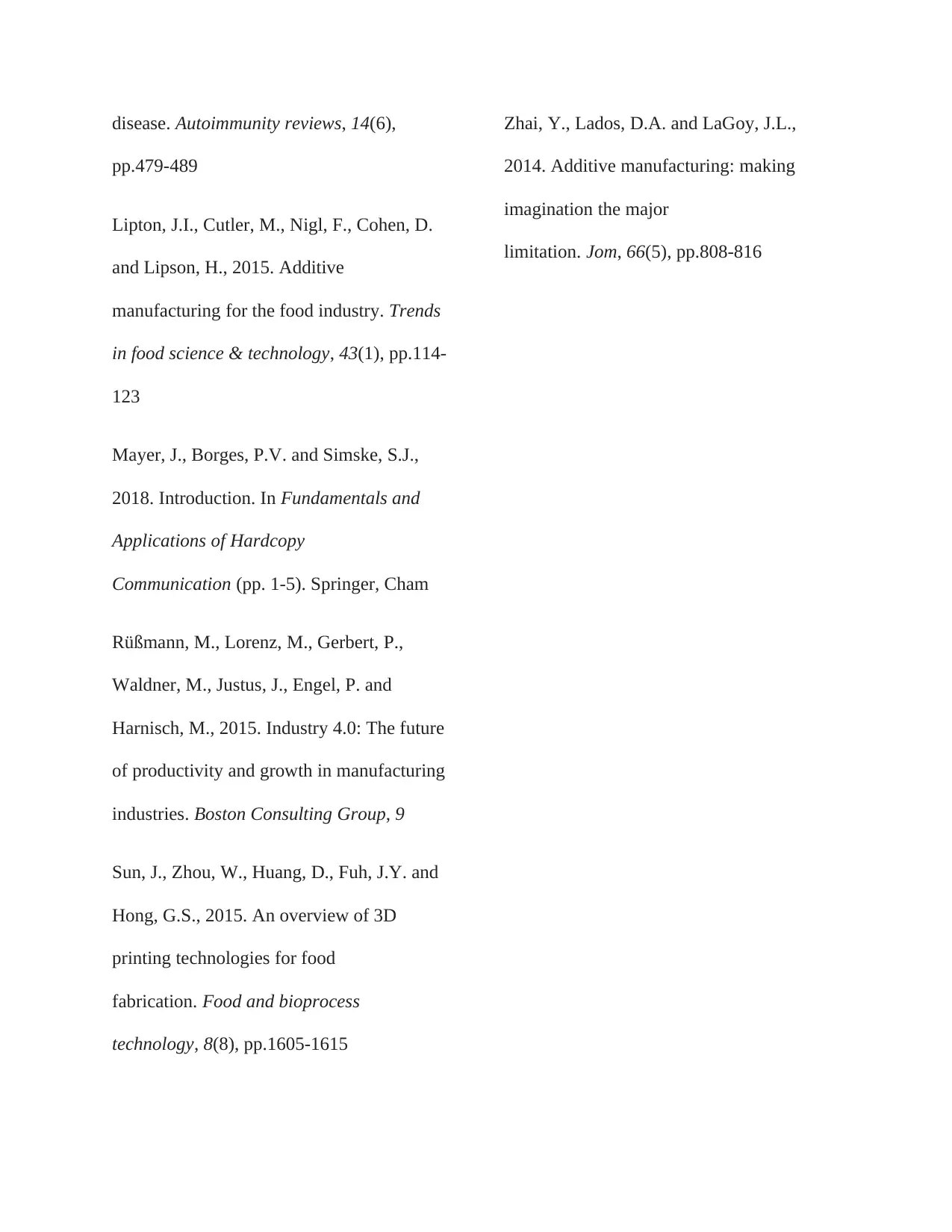
disease. Autoimmunity reviews, 14(6),
pp.479-489
Lipton, J.I., Cutler, M., Nigl, F., Cohen, D.
and Lipson, H., 2015. Additive
manufacturing for the food industry. Trends
in food science & technology, 43(1), pp.114-
123
Mayer, J., Borges, P.V. and Simske, S.J.,
2018. Introduction. In Fundamentals and
Applications of Hardcopy
Communication (pp. 1-5). Springer, Cham
Rüßmann, M., Lorenz, M., Gerbert, P.,
Waldner, M., Justus, J., Engel, P. and
Harnisch, M., 2015. Industry 4.0: The future
of productivity and growth in manufacturing
industries. Boston Consulting Group, 9
Sun, J., Zhou, W., Huang, D., Fuh, J.Y. and
Hong, G.S., 2015. An overview of 3D
printing technologies for food
fabrication. Food and bioprocess
technology, 8(8), pp.1605-1615
Zhai, Y., Lados, D.A. and LaGoy, J.L.,
2014. Additive manufacturing: making
imagination the major
limitation. Jom, 66(5), pp.808-816
pp.479-489
Lipton, J.I., Cutler, M., Nigl, F., Cohen, D.
and Lipson, H., 2015. Additive
manufacturing for the food industry. Trends
in food science & technology, 43(1), pp.114-
123
Mayer, J., Borges, P.V. and Simske, S.J.,
2018. Introduction. In Fundamentals and
Applications of Hardcopy
Communication (pp. 1-5). Springer, Cham
Rüßmann, M., Lorenz, M., Gerbert, P.,
Waldner, M., Justus, J., Engel, P. and
Harnisch, M., 2015. Industry 4.0: The future
of productivity and growth in manufacturing
industries. Boston Consulting Group, 9
Sun, J., Zhou, W., Huang, D., Fuh, J.Y. and
Hong, G.S., 2015. An overview of 3D
printing technologies for food
fabrication. Food and bioprocess
technology, 8(8), pp.1605-1615
Zhai, Y., Lados, D.A. and LaGoy, J.L.,
2014. Additive manufacturing: making
imagination the major
limitation. Jom, 66(5), pp.808-816
1 out of 11
Related Documents
Your All-in-One AI-Powered Toolkit for Academic Success.
+13062052269
info@desklib.com
Available 24*7 on WhatsApp / Email
![[object Object]](/_next/static/media/star-bottom.7253800d.svg)
Unlock your academic potential
Copyright © 2020–2025 A2Z Services. All Rights Reserved. Developed and managed by ZUCOL.




